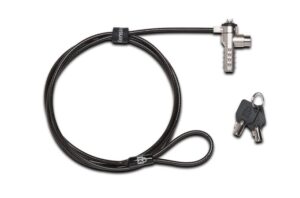Introduction
The Kensington lock 🔒 slot has developed into an important tool for protecting our priceless electronic gadgets in today’s digital world. When data security is of the most importance. A common feature of many electronic equipment. A similar feature on many electronic devices including laptops, desktop computers, and displays, is the Kensington lock 🔒 slot. It gives as a secure anchor point for Kensington locks, ensuring protection against theft and unauthorized access. This is a simple yet effective mechanism that gives users added peace of mind especially when using their devices in public or shared environments.

The Importance of Kensington Locks in Data Security
In this section, we will deliver deeper into the importance of Kensington lock 🔒 slots in maintaining data security. Discuss the high risks of leaving devices unsecured and the consequences of data breaches. Address how businesses and individuals can benefit from using Kensington locks to protect sensitive information.
Types of Kensington Locks
Here, outline the different types of Kensington locks 🔒 available in the market. Highlight their unique features, compatibility with various devices, and any advancements in locking technology.
How to Use a Kensington Lock
In this section, provide step-by-step instructions on how to properly use a Kensington lock 🔒 to secure a device. Include visual aids or infographics, if possible, to enhance the user experience.
Choosing the Right Kensington Lock
Guide readers on how to select the most suitable Kensington lock 🔒 for their specific devices. Consider factors such as lock 🔒 strength, cable length, and compatibility with various devices.
Best Practices for Kensington Lock 🔒 Slot Usage
Provide essential tips and best practices for maintaining device security using Kensington locks🔒. Offer insights into how businesses and individuals can combine Kensington locks🔒 into their security protocols.

What is the purpose of a Kensington lock 🔒 ?
By preventing theft and unauthorized access a Kensington lock 🔒 is designed to improve the security of electronic devices such as laptops, desktop computers, monitors, and projectors. The lock is made of a strong cable that may be covered around a stationary object, such as a desk or table, and a tiny metal anchor that is linked to the device. By placing the lock into the Kensington lock 🔒 slot (also known as a K-slot), which is often present on compatible devices, users may secure their gadgets. Users benefit from the piece of mind this physical security feature brings, especially in public areas or shared workspaces, by acting as a barrier against theft.

What is the Kensington lock 🔒slot on a laptop?
A laptop’s Kensington lock🔒 slot is a tiny, long aperture that is made to fit a Kensington lock🔒. On the back or side of the laptop’s chassis, the slot is frequently seen. This notch serves as a safe anchor point for the metal anchor of the Kensington lock.
A cable linked to a Kensington lock 🔒 must be coiled around a fixed object, such as a desk leg or another substantial structure, once the metal anchor has been put into the slot. Once the lock is attached, the laptop is physically secured to the immovable item, making it challenging for someone to remove the laptop and lowering the danger of theft, especially in open or busy settings.
Check out – Buy Kensington Lock Online in UAE







